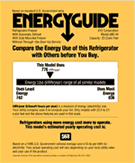Refrigerators and/or Freezers
Get Rebates,
Incentives & Services
Introduction
Refrigerators consume about 18% of all electricity in a typical Californian home — using more energy than any other single household appliance. Fortunately, refrigerators have become much more efficient in the past 20 years, using 60% less electricity on average than 20-year-old models.
If you have an old, inefficient refrigerator, you may be paying $280 a year in electricity in areas with high electricity rates. A new, more efficient model will lower your electric bill and save you money, which in turn will offset the cost of purchasing a new refrigerator.
Technology Options
Refrigerator/freezers come in three configurations: freezer on top, freezer on bottom, or side-by-side design. Refrigerators with the freezer on top are the most efficient models, followed by refrigerators with the freezer on bottom. Models with top-mounted freezers use 10-25% less energy than bottom-mount or side-by-side models, while an ice and water through-the-door feature will increase your refrigerator’s energy use by up to 20%.
Refrigerators, although turned "on" all the time, cycle on and off at a rate that depends on several factors. These factors include room temperature, freezer temperature, how well the unit is insulated, how often the door is opened, cleanliness of the coil, whether it is defrosted regularly, and the condition of the door seal. The harder your refrigerator has to work to maintain a constant temperature, the more energy it will use.
| Optimize Energy Performance Through Maintenance | ||
|
||
ENERGY STAR qualified models, which have to exceed federal energy use standards by 20%, use high-efficiency compressors, improved insulation, and more precise temperature and defrost mechanisms to improve energy efficiency. All these features cause the refrigerator to maintain a more constant temperature, reducing the number of times it must turn on and off.
All ENERGY STAR qualified refrigerators have an automatic defrost feature. Many models include automatic ice-makers and through-the-door ice dispensers. Qualified models are also available with top, bottom and side-by-side freezers.
Efficiency Benefits
If your refrigerator was made before 1993, it could be costing you over $100 each year to operate. Replace it with a new ENERGY STAR qualified model and you can cut your related energy costs in half. If you still have a fridge from the 1980s, replace it with an ENERGY STAR qualified model and save over $100 each year on your utility bills. Replace a fridge from the 1970s and save nearly $200 each year! Use the ENERGY STAR Savings Calculator to find out exactly how much money you’ll save by replacing your existing refrigerator. These savings can help offset the cost of purchasing a new refrigerator.
In addition to saving you money, many ENERGY STAR qualified refrigerators come with innovative features such as precise temperature controls and advanced food compartments to keep your food fresher, longer. If you do replace your refrigerator, be sure to recycle your old one.
Manufacturers
General Electric (GE), Maytag, Whirlpool and LG Electronics are some of the major manufacturers of ENERGY STAR qualified refrigerators. For a complete list, visit the ENERGY STAR website.
Purchasing Tips
|
||











